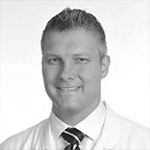
Meet Matthias Zumstein
Shoulder3T: Can you tell us about yourself?
Matthias Zumstein : My name is Matthias Zumstein. I am an orthopaedic shoulder and elbow surgeon from Bern, Switzerland. My focus in upper limb pathology and sports injuries followed a professional career as a Handball player, which took me to the Olympics Games and developed my interest in the complexities of shoulder and elbow function, particularly in athletes. I live with my wife and two daughters close to the beautiful town of Thun.
S3T: Tell us about your career.
MZ: Following medical training in Bern I undertook higher training in Zurich and Fellowship training in France and Australia with Pascal Boileau and Gteg Bain. As Team leader of the Shoulder, Elbow and Sports team at the Inselspital for over a decade I have built an extensive research portfolio and engaged extensively in training orthopaedic surgeons at all levels of experience resulting in becoming a Professor at the University of Bern. A recent move to Sonnenhof Orthopaedics has opened the next chapter of my career, with a desire to develop a specialist Shoulder, Elbow and Sports service where we can provide the highest level of up to date care for the general public and athletes alike.
S3T:What does your day-to-day activity consist of?
MZ: A standard week consists of two operating days and two days of outpatient clinic plus regular research activities, teaching and administration. I am still involved with the team at Inselspital, where I support the staff with complex cases through consultation and an operating list every second week.
S3T : Which recent innovation has most impressed you?
MZ: Prior to the development of the reverse geometry shoulder, the plight of patients with cuff arthropathy and an extremely suboptimal result from a hemiarthroplasty was difficult to manage. The rapid innovation and development of various reverse geometry designs has ignited the scientific community in the shoulder world and provided surgeons with options to help patients in need with these previously untreatable pathologies. Especially the next step of planning, intraoperative support and perioperative software tools will be very interesting to incorporate into daily activities.
From an instability perspective, the increasing acceptance and popularity of the Latarjet procedure, again offers the shoulder surgeon the chance to allow athletes a successful return to sports, both contact and overhead, in cases of instability that were previously extremely difficult to treat.
S3T : What advice would you give to future practitioners?
MZ: As with any vocation, motivation is key and a constant desire to develop and innovate. Learn the basics and then seek out those from whom you can benefit in terms of their knowledge and experience. Development and growth occurs most effectively on the edge or just outside one’s comfort zone and, whilst unsettling at times, I feel this has been key to pushing me forwards.
S3T : Why is Live Surgery a plus in our domain?
MZ: Live surgery provides an uncensored opportunity to see experienced surgeons at work and to learn from other approach to a case, particularly the difficulties that can arise. One of my Fellows always says he learnt the most during his training, not when things went well, but when problems occurred and his trainer showed experience and strategies to pursue a successful outcome. I think this is particularly true for live surgery and offers a chance to established orthopaedic surgeons to learn from others.
S3T : Can you tell us about the live surgery on the 9th of October.
MZ: I am looking forward to operate the 9th October with Dr. Valenti. It is a tremendous privilege to operate with him on the 3T platform. I am sure, that this is the future to give people the possibility to see what others do in live, their tricks, what they think and how they deal intraoperatively.
